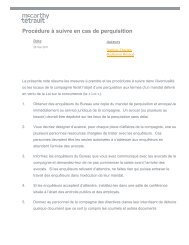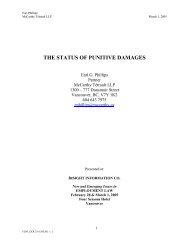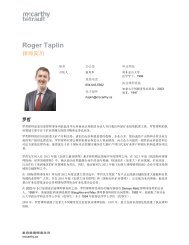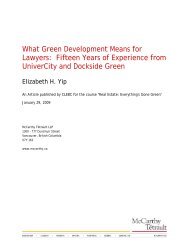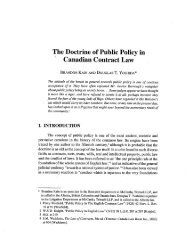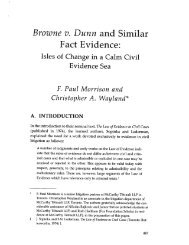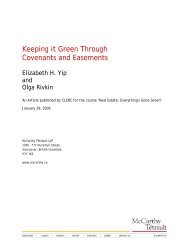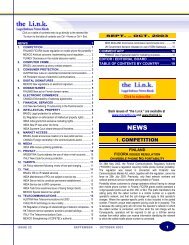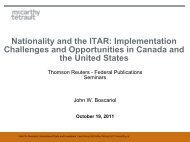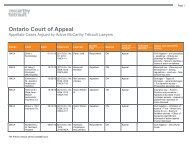Presentation Material - McCarthy Tétrault
Presentation Material - McCarthy Tétrault
Presentation Material - McCarthy Tétrault
Create successful ePaper yourself
Turn your PDF publications into a flip-book with our unique Google optimized e-Paper software.
Chris Falk<br />
Stefanie Morand<br />
<strong>McCarthy</strong> Tétrault LLP<br />
CRA might take the position that even a nominal capital gain will have the effect of grinding to<br />
nil the amount of the loss that can be carried back pursuant to subsection 164(6).<br />
While the authors are of the view that this interpretation should be rejected since it leads to an<br />
absurd result that is clearly contrary to the context and purpose of subsections 40(3.61) and<br />
164(6), they note as follows:<br />
• the CRA has invited practitioners who encounter scenarios where the grind might apply<br />
to contact CRA so that the issue can be reviewed further on a case-by-case basis; 66<br />
• if an advisor is consulted in respect of a possible post-mortem plan, the advisor:<br />
o<br />
o<br />
should counsel the executors/trustees to avoid incurring any capital gains if<br />
possible until after the estate’s first taxation year; and<br />
will need to assess the risk of the grind applying in assessing planning<br />
alternatives;<br />
• the discussion highlights the fact that subsection 164(6) is a highly technical provision<br />
that will not be available in all circumstances; 67<br />
• the relief (if any) afforded by subsection 40(3.61) does not apply in respect of subsection<br />
70(6) spouse trusts, alter ego trusts and joint spousal or common-law partner trusts; and<br />
• consideration could be given to structuring the planning to fit within subsection 69(5). 68<br />
More generally, practitioners are reminded that post-mortem planning can be complicated,<br />
expensive and time-sensitive, but can be greatly facilitated by advance planning. To this end, it<br />
is difficult to overstate the importance of good corporate and tax records, as well as the<br />
importance of having an integrated estate plan that is reviewed regularly in light of changing<br />
circumstances.<br />
ELIGIBLE DIVIDEND DESIGNATIONS FOLLOWING BUDGET 2012<br />
Prior to Budget 2012, the Act required that the recipient of a dividend from a Canadiancontrolled<br />
private corporation (a “CCPC”) be notified at the time the dividend was paid that the<br />
dividend was an eligible dividend. Late designations were not permitted, even where the<br />
corporation had sufficient income taxed at the general corporate rate to make an eligible<br />
dividend designation. Further, the Act did not permit a corporation to designate only a portion of<br />
a dividend paid as an eligible dividend.<br />
Budget 2012 proposed two helpful relieving measures which have since been enacted.<br />
66<br />
67<br />
68<br />
The authors note that they have made a general submission in this respect.<br />
Note also that, in some circumstances, the deceased will have sufficient loss carryforwards or tax credits to<br />
shelter the gain on death such that the subsection 164(6) loss carry-back is of no benefit to the deceased.<br />
Subsection 69(5) provides, in part, that where property of a corporation has been appropriated in any manner<br />
whatever to, or for the benefit of, a shareholder, on the winding-up of the corporation, subsections 40(3.4) and<br />
(3.6) do not apply in respect of any property disposed of on the winding-up.<br />
560600/422632<br />
MT DOCS 11864055v1G<br />
26



